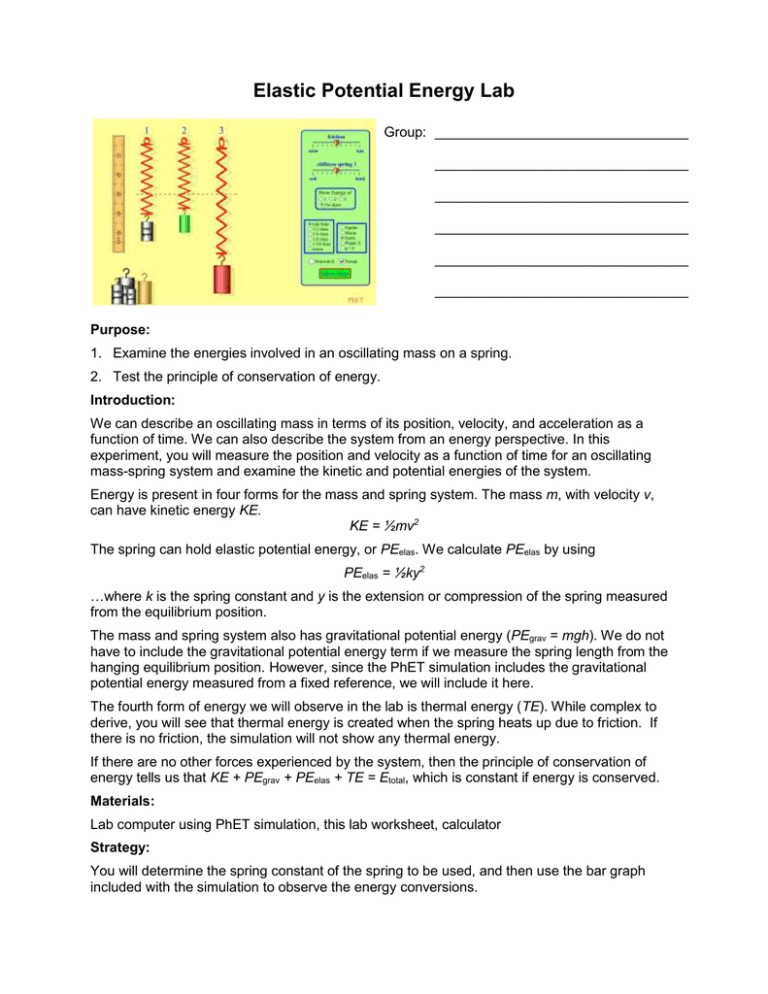Elastic Potential Energy Lab
advertisement

Elastic Potential Energy Lab Group: _________________________________ _________________________________ _________________________________ _________________________________ _________________________________ _________________________________ Purpose: 1. Examine the energies involved in an oscillating mass on a spring. 2. Test the principle of conservation of energy. Introduction: We can describe an oscillating mass in terms of its position, velocity, and acceleration as a function of time. We can also describe the system from an energy perspective. In this experiment, you will measure the position and velocity as a function of time for an oscillating mass-spring system and examine the kinetic and potential energies of the system. Energy is present in four forms for the mass and spring system. The mass m, with velocity v, can have kinetic energy KE. KE = ½mv2 The spring can hold elastic potential energy, or PEelas. We calculate PEelas by using PEelas = ½ky2 …where k is the spring constant and y is the extension or compression of the spring measured from the equilibrium position. The mass and spring system also has gravitational potential energy (PEgrav = mgh). We do not have to include the gravitational potential energy term if we measure the spring length from the hanging equilibrium position. However, since the PhET simulation includes the gravitational potential energy measured from a fixed reference, we will include it here. The fourth form of energy we will observe in the lab is thermal energy (TE). While complex to derive, you will see that thermal energy is created when the spring heats up due to friction. If there is no friction, the simulation will not show any thermal energy. If there are no other forces experienced by the system, then the principle of conservation of energy tells us that KE + PEgrav + PEelas + TE = Etotal, which is constant if energy is conserved. Materials: Lab computer using PhET simulation, this lab worksheet, calculator Strategy: You will determine the spring constant of the spring to be used, and then use the bar graph included with the simulation to observe the energy conversions. Procedure: Part I – Measure the Spring Constant 1. Point your web browser to the PhET site and locate the Masses and Springs simulation under Physics: Work, Energy & Power and select “Run Now!” or you may go directly to http://phet.colorado.edu/sims/mass-spring-lab/mass-spring-lab_en.html. 2. Move the dashed line even with the lower end of the springs with no masses attached. Line the ruler up to measure from the dashed line. 3. Hang 50 grams from the spring and record the increase in length of the spring in the table below. 4. Repeat this procedure using masses of 100g and 250g. 5. On the data table, calculate the weight of the three masses (F = m∙g). Using Hooke’s law (F = k∙x, ignoring the negative sign), determine the spring constant. Don’t forget that mass is calculated in kilograms and extension in meters. Mass (kg) Weight (N) Extension (m) Spring Constant (N/m) 0 0 0 ----- .050 .100 .250 Part II – Confirmation of Energy Exchange between Various Forms 1. In the center of the green box on the right side of the screen, select Show Energy of 1. 2. Attach the 250g mass to spring 1 and let it go, observing what happens on the bar chart. List the colors the simulation uses for each type of energy and see how they are added to determine the total energy. KE ___________ PEgrav ___________ PEelas ___________ Thermal ___________ 3. While keeping it attached to the spring, lift the mass to various heights (ie. Do work on the mass) and note what happens to the total energy. What happens to the total energy once the mass is released? 4. Lift the mass to the point where the total energy is at its lowest. What happens when the mass is released at this point? 5. Lift the mass to various heights and release it, observing the energy bar graph as you do. Describe the conversion of energy from the release of the mass until it comes to rest: 6. Set the friction to “none” and describe the motion of the mass and any differences in the energy bar graph: Part III – Extra Credit (Time Permitting) 1. Use Hooke’s Law to measure the mass of the three unlabeled weights. (Resetting the friction to a moderate amount will dampen the oscillations and make this easier.) Weight Extension (m) Spring Const (N/m) Weight (N) Mass (kg) GREEN YELLOW RED 2. Spring 3 is a special spring, with an adjustable spring constant. In the center position of the slider bar, it has the same spring constant as the other two springs, but at either end it has very different properties. Using the table below and the same procedure you used in part I, calculate the spring constant at both ends of the scale for spring 3. Softness Mass (kg) Weight (N) Extension (m) Spring Const (N/m) soft hard 3. Clicking on the “Show Help” button causes a yellow “No Help” button to appear. Click on the “No Help/Don’t Bother” button and tell me the movie reference for the resulting audio quote:


